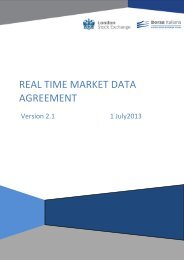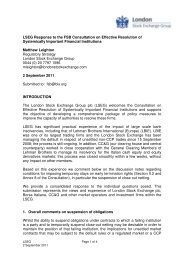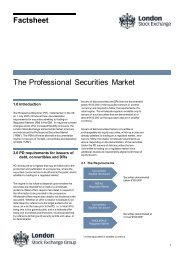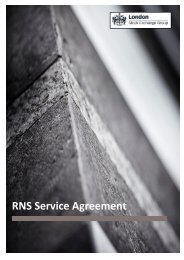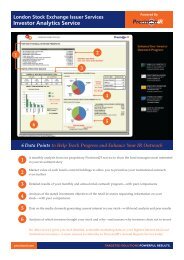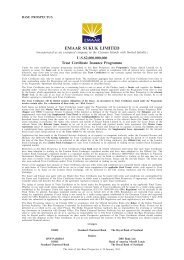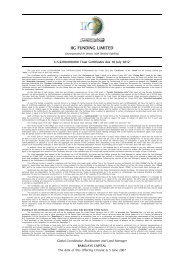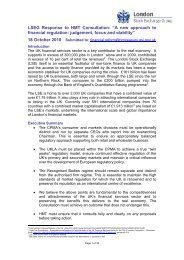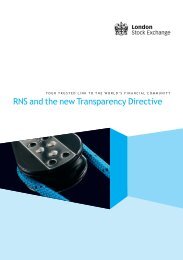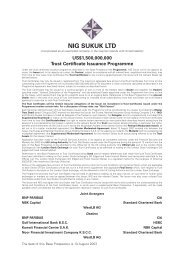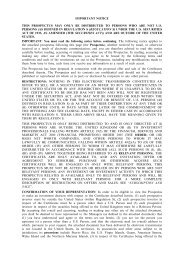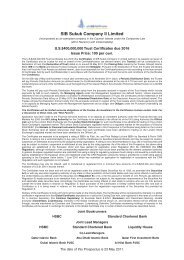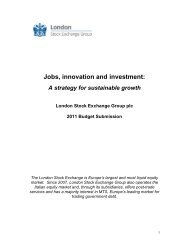Tabreed 06 Prospectus - London Stock Exchange
Tabreed 06 Prospectus - London Stock Exchange
Tabreed 06 Prospectus - London Stock Exchange
Create successful ePaper yourself
Turn your PDF publications into a flip-book with our unique Google optimized e-Paper software.
NATIONAL CENTRAL COOLING COMPANY (PJSC)<br />
NOTES TO THE CONSOLIDATED FINANCIAL STATEMENTS<br />
31 December 2005<br />
2.4 SIGNIFICANT ACCOUNTING POLICIES continued<br />
Revenue recognition<br />
Sales are recognised when the significant risks and rewards of ownership of the goods and services<br />
have passed to the buyer and the amount of revenue can be measured reliably. For sale of chilled<br />
water, revenue comprises of available capacity and variable output provided to customers and is<br />
recognised when services are provided.<br />
Contract revenue represents the total sales value of work performed during the year, including the<br />
estimated sales value of contracts in progress assessed on a percentage of completion method,<br />
measured by reference to total cost incurred to date to estimated total cost of the contract. Provision<br />
is made for any known losses and contingencies.<br />
Interest revenue is recognised as the interest accrues (using the effective interest method that is the<br />
rate that exactly discounts estimated future cash receipts through the expected life of the financial<br />
instruments to the net carrying amount of the financial asset).<br />
Capital work in progress<br />
Capital work in progress is recorded at cost which represents the contractual obligations of the<br />
Company for the construction of the plant. Allocated costs directly attributable to the construction of<br />
the asset are capitalised. The capital work in progress is transferred to the appropriate asset category<br />
and depreciated in accordance with the Company’s policies when construction of the asset is<br />
completed and commissioned.<br />
Property, plant and equipment<br />
Property, plant and equipment is stated at cost less accumulated depreciation and any impairment in<br />
value. Land is not depreciated. Depreciation is calculated on a straight-line basis over the estimated<br />
useful lives of the assets as follows:<br />
Plant and buildings over 25 years<br />
Furniture and fixtures over 3 to 4 years<br />
Office equipment and instruments over 3 to 4 years<br />
Motor vehicles over 4 to 5 years<br />
The carrying values of property, plant and equipment are reviewed for impairment when events or<br />
changes in circumstances indicate the carrying value may not be recoverable. If any such indication<br />
exists and where carrying values exceed the estimated recoverable amount, the assets are written down<br />
to their recoverable amounts.<br />
Expenditure incurred to replace a component of an item of property, plant and equipment that is<br />
accounted for separately is capitalised and the carrying amount of the component that is replaced is<br />
written off. Other subsequent expenditure is capitalised only when it increases future economic<br />
benefits of the related item of property, plant and equipment. All other expenditure is recognised in<br />
the income statement as the expense is incurred.<br />
The Company performs regular major overhaul of its district cooling plants. When each major<br />
overhaul is performed, its cost is recognised in the carrying amount of the item of property, plant<br />
and equipment as a replacement if the recognition criteria are satisfied. The cost recognised is<br />
depreciated over the period till the next planned major overhaul.<br />
Investments in associates<br />
The Company’s investments in associates are accounted for under the equity method of accounting.<br />
These are entities in which the Company has between 20% to 50% of the voting power or over which<br />
it exercises significant influence and which is neither a subsidiary nor a joint venture. Investments in<br />
associates are carried in the balance sheet at cost, plus post-acquisition changes in the Company’s<br />
share of net assets of the associate, less any impairment in value. The income statement reflects the<br />
Company’s share of the results of its associates.<br />
F-19



